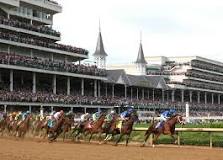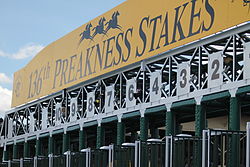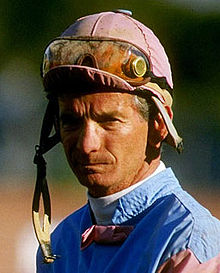Kentucky Derby Special Moments
The Kentucky Derby, presented by Woodford Reserve, has been a Grade 1 stakes race for three year old thoroughbred horses for many years.
The race distance is one and a quarter miles and is run on the dirt racetrack in Louisville, Kentucky's Churchill Downs. Colts and geldings carry 126 pounds (57 kg) in the race, while fillies carry 121 pounds (55 kilograms).

It's almost impossible to pick the most dramatic all-time finish in the Kentucky Derby as there is usually a remarkable, nail biting end to all of the 141 editions. In fact some of them think they have won and end up being disqualified.
The Kentucky Derby is the first of the U.S. races which make up the Triple Crown of Thoroughbred Racing; the others being the Preakness Stakes and Belmont Stakes.
It takes a special horse to win all three - a feat only achieved 13 times in over 100 years.
Kentucky Derby Bets
The more money wagered on a horse the greater its chances of winning and the lower its odds. That's why the "favorite" always has the lowest odds, as the most money is bet on that horse.
Before placing a bet be sure to check on our betting management tips.
If it wins, the pool must be divided among all those who bet on it, which means that the payout is small.
The last six editions of the Kentucky Derby have been won by the favorite so that’s why it is important to obtain the best Kentucky Derby odds possible.
The Kentucky Derby tied the Breeder’s Cup races with the Whitney Handicap as the top Grade 1 race in the United States in the 2015 listing of the International Federation of Horseracing Authorities (IFHA).
So here are some of the most breathtaking moments in the history of the Kentucky Derby.

Mine That Bird (2009)
Everyone loves an underdog victory story. Mine That Bird was popularly called “Racing’s Newest Cinderella”, for he is a prime example of the unpredictable nature of a typical Kentucky Derby winner. This admirable gelding, in his early racing career, was bought for only $9,500.
He performed well at the start of his career in Canada and continued to improve on moving to the southwestern part of the United States which included several changes of ownership. In early 2009, Chip Woolley took over as his new trainer.
A few days before the Kentucky race, Chip Woolley loaded Mine That Bird into a trailer on the back of his truck and still recovering from a broken ankle, drove him over 1,000 miles from New Mexico to Kentucky to participate in the contest.
In the race itself, Mine That Bird missed the break at the start and was so far behind that the commentator failed to even notice he was running.
By the final turn, jockey Calvin Borel had sneaked into contention along the rail and conjuring up a sudden burst of speed exploded into the lead, going away to win by over 6 lengths.
He became the second biggest upset winner in the history of the Kentucky Derby, his 50/1 price being second only to Donerail who won at 91/1 in 1913.
In fact, within five years of his win, a book and a movie titled “50-1” came out based on Mine That Bird’s underdog story and legacy.
Grindstone (1996)
Grindstone was the son of Unbridled from the mare Buzz My Bell, bred and owned by William T. Young's Overbrook Farm. Before the Kentucky Derby, Grindstone had won the Derby of Louisiana and was second in the Derby of Arkansas.
Only five days after his Kentucky Derby victory, Grindstone was retired when knee chips were found in his leg. He is the first horse to retire immediately after a win in the Kentucky Derby since Bubbling Over in 1926.
Iron Leige (1957)
Similar to Grindstone, Iron Liege was an American thoroughbred racehorse, bred by Horace A. Jones of Calumet Farm, and was well known for its most dramatic win. The 1957 Kentucky Derby was remarkable in Derby history for two reasons.
Firstly, it boasted one of the highest calibre fields, with some of the most athletic thoroughbreds racing against each other – including two Hall of Fame horses, Bold Ruler, and Round Table.
Secondly, it resulted in one of the Kentucky Derby’s most dramatic finishes.
Iron Liege and Gallant Man, with future Hall of Fame jockey Bill Shoemaker aboard, were neck-and-neck on the finishing stretch.
However Bill Shoemaker on Gallant Man misjudged the pole of the finish line and standing up to celebrate his supposed victory, conceded the race to Iron Leige by a nose.

Footnote
Horse racing is a beautiful sport that has stood the test of time and these extraordinary events have contributed greatly to maintaining its popularity and rewarding its followers.
But beware of becoming obsessive in your betting habits, never bet more than you can afford to lose. To enjoy the spectacle and horse racing's special moments will bring its own reward.
Wagering on the 2025 Kentucky Derby
Join my followers of the Horses To Follow (12.5 pts profit in just 10 advised horses this month). You will receive by email all my horses to follow for just £5 per month.
To subscribe just click the Paypal link below

You Might Like These
Kentucky Derby Odds: Will there be a hometown favorite?
Preakness Stakes Odds: Will the champions face fresh challengers?
Belmont Stakes Odds: At 1½ miles, stamina becomes the great equalizer as longshots can threaten.
Breeders' Cup Odds: International talent collides with American speed, reshuffling expectations across the board.
Dubai World Cup Odds: Under desert lights, can a Japanese sensation prevail against the world's elite.
Pegasus Cup Odds: Retirement beckons for champions seeking one final payday at America's richest race.
Bet on Horses: Every wager tells a story of hope against mathematical probability.
Kentucky Derby Betting: Beneath fancy hats and mint juleps, fortunes change hands with each thundering hoof.
Preakness Stakes Betting: The middle jewel rewards those who recognize when Derby form holds true.
Belmont Stakes Betting: Distance separates champions from pretenders when the final furlong tests them all.
Breeders Cup Betting: Global racing converges for two days where value hides in plain sight.

Returns Policy: Once a customer has agreed to pay for a product or service no returns will be permitted or payments returned.
All PayPal transactions are subject to the PayPal Privacy Policy
Privacy Policy: Personal details provided to this site by an individual may be shared with third parties unless requested otherwise.
Above policies updated 15 March 2018




